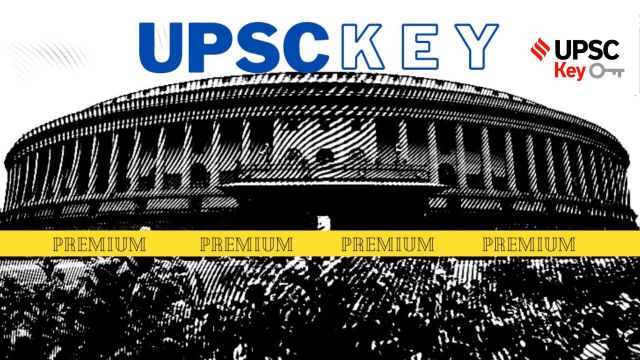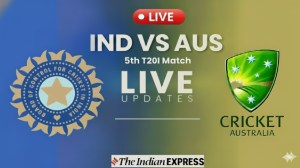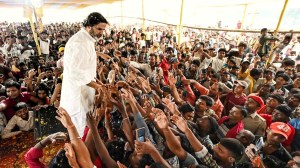
CJI names Justice Chandrachud, most senior judge, as successor
Syllabus:
Preliminary Examination: Indian Polity and Governance
Main Examination: General Studies II: Structure, organization and functioning of the Executive and the Judiciary
Key Points to Ponder:
• What’s the ongoing story- Clearing the decks for the appointment of the 50th Chief Justice of India, CJI U U Lalit Tuesday recommended the name of Justice D Y Chandrachud, the second most senior judge of the Supreme Court, as his successor. If approved by the government, Justice Chandrachud will have a tenure of two years as CJI. His father, Y V Chandrachud, too served as the CJI and had a stint of over 7 years.
• Personality in News-Justice D Y Chandrachud
Story continues below this ad
• During his tenure in the Supreme Court, Justice Chandrachud penned some very important judgments-Know some landmark verdicts
• During Justice Chandrachud’s two-year tenure, the collegium he will head will potentially make as many as 18 recommendations for appointment of judges to the Supreme Court. It will be an unusual collegium-What will the Chandrachud collegium look like?
• What is a 5+1 collegium?
• Do You Know-Articles 124 to 147 in Part V of the Constitution deal with the organisation, independence jurisdiction, powers, procedures and so on of the Supreme Court. The Parliament is also authorised to regulate them.
• What is the sanctioned strength of Supreme Court Judges in India?
• Who appoints the Chief Justice of India?
Story continues below this ad
• How is the seniority of judges in the Supreme Court decided?
• What does the Collegium consider while making the recommendation?
• National Judicial Appointments Commission (NJAC) Act 2014-Know the key highlights
• Supreme Court on NJAC Act 2014 (99th Constitutional Amendment Act)-know in detail
• First Judges Case (1982), Second Judges Case (1993) and Third Judges Case (1998)-Know in detail
Story continues below this ad
• What was the Supreme court’s ruling in the Second Judges case (1993), with respect to the appointment of a judge?
• Third Judges case (1998) and Supreme Court’s ruling in case of the appointment-What was the Supreme Court’s ruling?
• The National Judicial Appointments Commission Act of 2014 and the Collegium System-Compare and Contrast
• What are the qualifications required for a person to be appointed as the Chief Justice of India?
Story continues below this ad
• A person appointed as a Chief Justice of Supreme Court, before entering upon his office, has to make and subscribe an oath or affirmation before whom?
• The Constitution has made certain provisions to safeguard and ensure the independent and impartial functioning of a Judges-Know in detail
• Jurisdiction And Powers Of Chief Justice of India-Know in detail
• Executive Vs Judiciary for appointment of judges in higher judiciary-Know in detail
Other Important Articles Covering the same topic:
📍How is seniority decided in the SC?
📍Supreme Court strikes down NJAC, revives collegium system
Story continues below this ad
📍Debate over the collegium system: How are SC and HC judges appointed?
📍Principle of seniority and next CJI Chandrachud ‘5+1’ collegium
Interpol rejects Delhi Red Corner request for Khalistan separatist
Syllabus:
Preliminary Examination: Current events of national and international importance.
Mains Examination:
• General Studies II: Effect of policies and politics of developed and developing countries on India’s interests, Indian diaspora.
• General Studies III: Role of external state and non-state actors in creating challenges to internal security.
Key Points to Ponder:
• What’s the ongoing story-In a setback to the Centre’s case against Khalistan separatist Gurpatwant Singh Pannun, the Interpol has rejected India’s second request to issue a Red Corner Notice on terror charges against the Canada-based founder and legal advisor of pro-Khalistan outfit Sikhs for Justice (SFJ), stating that Indian authorities failed to provide sufficient information to support their case.
• Who is Gurpatwant Singh Pannun?
• Why India wants Gurpatwant Singh Pannun?
• What you know about the Khalistan movement?
• What are the Historical events responsible for Khalistan?
• How Khalistan movement affected Indo-Canadian relationship?
• Why Interpol rejected India’s request?
• What India actually requested for?
• Who is the ‘Sikhs for Justice (SFJ)’ group?
Story continues below this ad
• Imagine you are the victim of a crime committed by someone from another country. How can police catch the person?
• What is International Criminal Police Organization?
• Who makes up INTERPOL?
• What INTERPOL do?
• What is a Red Notice?
• Is Red Notice a warrant of arrest?
Other Important Articles Covering the same topic:
📍Who are Gurpatwant Singh Pannun and the SFJ, whom India wants put on Interpol’s Red Notice?
📍India’s request for action against Pannun rejected: What is the Interpol, and what is a Red Notice?
EXPRESS NETWORK
30 tribals held for violence outside Jharkhand court
Syllabus:
Preliminary Examination: Economic and Social Development-Sustainable Development, Poverty, Inclusion, Demographics, Social Sector Initiatives, etc.
Story continues below this ad
Mains Examination: General Studies I: The Freedom Struggle — its various stages and important contributors/contributions from different parts of the country.
Key Points to Ponder:
• What’s the ongoing story- As many as 30 Tana Bhagat sect tribals were arrested and sent to judicial custody in connection with the Monday’s ‘violent protest’ outside the Latehar district courts, police said.
• According to Latehar SP Anjani Anjan, “They are misinterpreting the 5th Schedule of the Constitution and were demanding complete self-rule with no role of courts or governments”-What is 5th Schedule of the Constitution?
• Tana Bhagats-Know in detail
• Tana Bhagats were formed by whom?
• What do you know about Tana Bhagat Movement?
• Who was the saint Jatra Bhagat?
• Why Tana Bhagat Movement-Reasons?
• Impact/implications or consequences of Tana Bhagat Movement?
Other Important Articles Covering the same topic:
📍After Niyamgiri
THE CITY
It’s official: Illegal mining is rampant in Aravallis
Syllabus:
Preliminary Examination: General issues on Environmental ecology, Bio-diversity and Climate Change – that do not require subject specialization.
Story continues below this ad
Mains Examination: General Studies III: Conservation, environmental pollution and degradation, environmental impact assessment.
Key Points to Ponder:
• What’s the ongoing story- A report of a joint committee, formed on orders of the National Green Tribunal to ascertain the extent of illegal mining at 16 locations in Aravalli region in Gurgaon, Faridabad and Nuh districts of Haryana, has found instances of mining activity at several locations in the region despite prohibitory orders. It has also found trenches at some sites due to excavation.
• Map Work-Aravalli Range (North to south and east to west stretch)
• Which peak is the highest point of the Aravalli Range?
• The Aravalli Range is arguably the oldest geological feature on Earth, having its origin in which era?
• The Aravalli Range, is believed to be the oldest range of fold mountains in India-True or False?
• By the way, what is fold mountain?
• The mining industry in India-Know in detail
• How illegal mining harms the Aravalli in particular and country in general be it economically, politically and administratively -Brainstorm
• How environment is affected by the illegal mining?
• What are the challenges faced by an administrator to control illegal mining?
• Illegal mining and Political Nexus-Do you agree with the same?
• Do you Know– According to a 2018 report by the Supreme Court-appointed Central Empowered Committee (CEC), illegal mining has destroyed 25% of the Aravalli range in Rajasthan since 1967-68.
• Supreme Court on illegal mining-Know in detail
Other Important Articles Covering the same topic:
📍Aravallis broken beyond repair
THE EDITORIAL PAGE
How to discuss Hinduism
Syllabus:
Preliminary Examination: Indian Polity and Governance-Constitution, Political System, Panchayati Raj, Public Policy, Rights Issues, etc.
Mains Examination: General Studies II: Indian culture and Salient features of Indian Society, Diversity of India.
Key Points to Ponder:
• What’s the ongoing story-Pratap Bhanu Mehta writes-Discussion of Hinduism requires greater theological imagination, philosophical and historical subtlety
• Hindu, Hinduism and Hindutva-What is the difference between these three?
• Who is a Hindutvavadi?
• One of India’s greatest educationists and the first Vice-President S Radhakrishnan in his book ‘The Hindu View of Life’ defined Hindus-How he defined Hindu?
• How Hinduism is defined by scholars around the world and scholars in India?
• What Supreme Court of India said on Hindu, Hindutva and Hinduism?
• ‘Hindutva’ is being projected as a divisive ideology or radical-why?
• “Colonialism, of course, transforms the way we talk about Hinduism through its legal codification, enumeration, and translation. But the “colonial invention” thesis borders on nonsense”-The Author is pointing what?
• “Saying Hinduism is a colonial construct does not delegitimise Hindutva; it reinforces its central claim about the blasé ways in which Hinduism is sometimes conceptualised. The debate over Hinduism requires greater theological imagination, philosophical subtlety and historical nuance”-Discuss
Other Important Articles Covering the same topic:
📍Happy with my hinduism
📍Why inclusive Hindutva is a myth
THE IDEAS PAGE
A misdiagnosis of NPAs
Syllabus:
Preliminary Examination: Economic and Social Development-Sustainable Development, Poverty, Inclusion, Demographics, Social Sector Initiatives, etc.
Mains Examination: General Studies III: Indian Economy and issues relating to planning, mobilization, of resources, growth, development and employment.
Key Points to Ponder:
• What’s the ongoing storyAbhishek Kumar , Rakesh Mohan , Divya Srinivasan Writes-Probing the links between twin balance sheet crisis and external commodity shocks could lead to a better understanding of the problem.
• What Is a Nonperforming Asset (NPA)?
• How Nonperforming Assets (NPA) Work
• Know the types of Nonperforming Assets (NPA)
• Nonperforming Assets (NPA) issue in India-Why it is matter of Concern?
• What can be the possible reasons for NPAs?
• How NPAs impact?
• What are the steps taken by GOI to curb NPAs?
• “It has been argued as a problem that the problem relates to public sector banks because they have a disproportionate share of NPAs”-Why Public sector banks have more NPAs than others?
• “The difference in the business models of public and private sector banks has not received due attention”-How far you agree?
Other Important Articles Covering the same topic:
📍Nonperforming Asset (NPA): What It Is and Different Types
📍 Meaning: Non-performing assets
EXPLAINED
IRANIAN KURDS
Syllabus:
Preliminary Examination: Current events of national and international importance.
Mains Examination: General Studies II: Effect of policies and politics of developed and developing countries on India’s interests
Key Points to Ponder:
• What’s the ongoing story- Nationwide protests over the death of a young Iranian Kurdish woman in the custody of Iran’s morality police have been at their most intense in the northwestern areas where the majority of the country’s 10 million Kurds live. The protests, now in their fourth week as demonstrators defy a crackdown by security forces, pose the biggest challenge to Iran’s clerical rulers in years.
• Who are Kurds?
• Where do they come from?
• Do You Know- Kurdish nationalism stirred in the 1890s when the Ottoman Empire was on its last legs. The 1920 Treaty of Sevres, which imposed a settlement and colonial carve-up of Turkey after World War One, promised Kurds independence. Three years later, Turkish leader Kemal Ataturk tore up that accord. The Treaty of Lausanne, ratified in 1924, divided the Kurds among the new nations of the Middle East.
• Why don’t they have a state?
• For Your Information- Kurdish separatism in Iran first bubbled to the surface with the 1946 Republic of Mahabad, a Soviet-backed state stretching over Iran’s border with Turkey and Iraq. It lasted one year before the central government wrested back control. Iran’s 1979 Islamic Revolution touched off bloodshed in its Kurdistan region with heavy clashes between the Shi’ite revolutionaries and the Kurdish Party of Iranian Kurdistan (KDPI) which fought for independence.
• What is India’s stand on Kurds?
Other Important Articles Covering the same topic:
📍Explained: Who are the Kurds, and why is Turkey attacking them in Syria
The lingering monsoon
Syllabus:
Preliminary Examination: Indian and World Geography
Mains Examination: General Studies I: Important Geophysical phenomena such as earthquakes, Tsunami, Volcanic activity, cyclone etc., geographical features and their location-changes in critical geographical features (including water-bodies and ice-caps) and in flora and fauna and the effects of such changes.
Key Points to Ponder:
• What’s the ongoing story-Incessant rain over Delhi and several other parts of North and Northwest India over the last few days provide further evidence of the shifting patterns in monsoon activity over the Indian subcontinent. Not only has monsoon rainfall become more erratic — fewer rainy days but more intense rain — the monsoon season, earlier confined neatly to the four-month June-September period, is clearly spilling over into October now.
• The withdrawal dates for North, Northwest and Central India were pushed back by one to two weeks to account for the trends witnessed over the last 50 years-Why change in the pattern?
• Change in pattern is due to climate change-you agree with same?
• The changing patterns and increased instances of erratic monsoon behaviour is creating forecasting complications for the IMD-What sort of complications and challenges in particular?
• Monsoon change in pattern and its impact-know in detail
• Monsoon and India-How both are interlinked?
• The southwest monsoon season and the retreating monsoon-Know the difference
• The Sea Surface Temperature (SST), Mean Sea Level pressure in east Asia, The surface air temperature over northwest Europe and the warm water volume of the equatorial Pacific Ocean-Impact on Monsoon
• Coriolis Force and role in Monsoon-Know in detail
• What are the Niño and La Niña?
• EL Nino Southern Oscillation or ENSO impact on Monsoon
• Indian Ocean Dipole-Know in Detail
• Factors Influencing South-West Monsoon Formation
• What is Inter Tropical Convergence Zone?
• What do you understand by the expression ‘Onset of the South-West Monsoon’?
• Impact of Monsoons on Life in India-Economical, Cultural and Social
• India Meteorological Department and Monsoon Prediction in India
• How much rainfall does India receive on average in a year?
• When is the Long Period Average (LPA) revised?
• Why has it been downgraded?
• Has the all-India quantitative rainfall reduced?
Other Important Articles Covering the same topic:
📍What downgrade in average monsoon rainfall means
ECONOMY
OECD global framework in place, India to focus on crypto asset regulations
Syllabus:
Preliminary Examination: Current events of national and international importance.
Mains Examination: General Studies II: Bilateral, regional and global groupings and agreements involving India and/or affecting India’s interests.
Key Points to Ponder:
• What’s the ongoing story- The government plans to move ahead with its discussions for framing an overarching regulatory and taxation framework for crypto assets, a move which had been stalled in anticipation of a global consensus and framework on the issue. With the Organisation for Economic Co-operation and Development (OECD) giving final shape to the cross-border reporting framework for crypto assets, officials in the know said that India will also now consider moving ahead with finalising the contours of its policies.
• The OECD released a new global tax transparency framework, “Crypto-Asset Reporting Framework (CARF)”-Know the its key features
• “It is said that the OECD’s a new global tax transparency framework, Crypto-Asset Reporting Framework (CARF) is in line with earlier proposal of G20 that the OECD develop a framework for the automatic exchange of information between countries on crypto-assets”-What’s the background?
• Cryptocurrency or Virtual Currency-what do you understand by this term?
• Inception of Cryptocurrencies in India-Know in detail
• RBI’s first circular regarding cryptocurrencies in 2013-Know in detail
• Demonetisation and RBI’s Banking Ban on Crypto-Why ban on crypto
• The Cryptocurrency and Regulation of Official Digital Currency Bill, 2021-Highlights
• Supreme Court on Cryptocurrency in 2018
• What are the issues involving Cryptocurrency in mainstream financial Markets or simply market?
• What is GOI’s Stand on Cryptocurrencies?
• What does the Organization for Economic Cooperation and Development do?
• What is the main purpose of OECD?
• Is India a part of Organisation for Economic Cooperation and Development?
Other Important Articles Covering the same topic:
📍Crypto-Asset Reporting Framework and Amendments to the Common Reporting Standard
ONDC beta testing likely in Delhi: How does the system work?
Syllabus:
Preliminary Examination: Current events of national and international importance.
Mains Examination: General Studies III: Science and Technology- developments and their applications
Key Points to Ponder:
• What’s the ongoing story-The Open Network for Digital Commerce (ONDC), which is a government-backed project aimed at enabling small merchants and mom-and-pop stores in parts of the country to access processes and technologies that are typically deployed by large e-commerce platforms such as Amazon and Flipkart, is expected to extend beta testing in Delhi after having commenced services in Bengaluru.
• What is Open Network for Digital Commerce (ONDC)?
• What are the plans for Delhi?
• How does ONDC work?
• What are the challenges ONDC aims to address?
Other Important Articles Covering the same topic:
📍Explained: Govt’s Open Network for Digital Commerce, and what Microsoft joining it means
For any queries and feedback, contact priya.shukla@indianexpress.com
The UPSC KEY Indian Express is now on Telegram. Click here to join our channel and stay updated with the latest Updates.

































